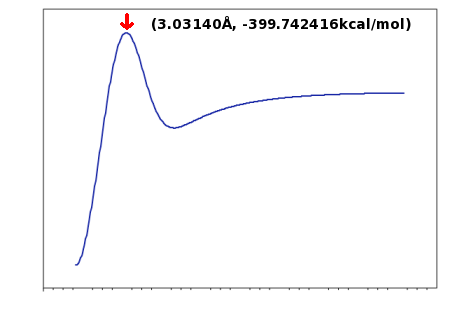It is possible to find the transition state of a reaction in MOPAC2012, after calculating the reaction path, using the TS keyword.
In this tutorial, we will compute the reaction path for the coordination of the water molecule in UDOMIJ [Aqua-(diethylenetriamine-bis(acetic acid methylamide)triacetato)-gadolinium] below:

- First, please follow the steps of the Reaction Path tutorial before continuing.
- As starting geometry, we can use the geometry corresponding to the highest energy (heat of formation) of the reaction path calculation. To visualize this you can plot the energy versus the reaction coordinate using a software of your preference. For example, the highest energy calculated during the reaction path calculation for the complex of -399.742416kcal/mol is obtained for a H2O-Ln bond distance of 3.03140Å.
- This can be seen in the reaction path profile below:

- Open the MOPAC2012 output file of the reaction path calculation of the complex. For convenience, we provide udomij_opt_int.out.zip. Copy the highest energy geometry to a new file, replace all keywords by AM1 AUX SPARKLE TS GEO-OK CHARGE=0 and replace -1 by +1 on the oxygen directly coordinated to the Gd(III) ion in the 7th atom in line 10.
- Save the new input file. For convenience, we provide udomij_opt_int_ts.mop, and run it on MOPAC2012.
- This calculation will optimize the transition state geometry. Remember that the highest energy geometry of the reaction path calculation will probably not be the transition state, albeit close to it. The TS keyword uses this initial geometry to refine the true tansition state.
- Starting from the optimized transition state geometry, we can also perform an "Intrinsic Reaction Coordinate" calculation to visualize the reaction path.
- To do so, edit the .arc file of the transition state optimization. For convenience, we provide udomij_opt_int_ts.arc, generated by MOPAC2012 which should then be modified into the optimized .mop file using your favorite text editor as such: open the .arc file and save it with another name with the .mop extension. Find the line which reads FINAL GEOMETRY OBTAINED and remove everything above and including this line.
- Replace the keyword TS by the keyword IRC=1*. Save the file. For convenience we provide udomij_opt_int_irc.mop.
- Run this new .mop file in MOPAC2012.
- If you run into any problems, please review the warning in the bottom part of the tutorial Drawing Complexes.
- Upon completion, a file with extension .xyz will be created by MOPAC2012. For convenience we provide a zipped udomij_opt_int_irc.xyz.zip.
- To visualize a movie of the intrinsic reaction coordinate, open Gabedit and click on “Display Geometry/Orbitals/Density/Vibration” button:
 . This will open a new window called “Gabedit: Orbitals/Density/Vibration”.
. This will open a new window called “Gabedit: Orbitals/Density/Vibration”.
- Right click on the black screen and choose the option “Animation” > "several geometries (Convergence/IRC)" in the menu that appears. A new window, called "Multiple Geometries", will appear. Go to the "File" option in this window, and select “Read a xyz file” from the drop down menu that apears. In the new window that appears, named "Read geometries form a XYZ file", navigate to the proper .xyz file and open it.
- Now, position the complex as you wish, for an easy view. Notice that a new option will appear in the bottom of the "Multiple Geometries" window called "Play". Click on it to watch the movie. Below, we provide a YouTube version of this movie: